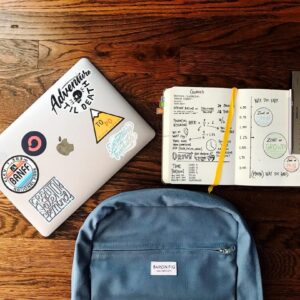
STEM stands for science, technology, engineering, and mathematics. Fields that fall into the STEM category typically account for a wide swath of professions that offer excellent pay and prestige, as well as an opportunity to impact significant societal innovations. STEM professions are also increasingly sought after for their job security, due to sweeping technological upgrades such as automation rendering many labor and service jobs obsolete while increasing demand for technology professionals.
Given the security and positive attention associated with these professions, this workforce shift is an opportunity to promote egalitarianism through diverse representation in STEM fields. However, unfortunately, many factors have limited access to these fields for many demographics, including people with disabilities. However, with support and cultivation of interest from a young age, people with disabilities may be able to benefit from a more fair footing in terms of pursuing a STEM career.
Identifying Barriers to STEM Education for Students With Disabilities
As mentioned, people with disabilities face many obstacles on their way to a STEM career that others either do not or experience to a lesser degree. These challenges will depend on the individual and their circumstances but may include:
- Physical barriers to learning opportunities for people with mobility disabilities;
- Decreased time available to pursue learning opportunities as they manage their disability
- Decreased mental and emotional resources available to pursue learning opportunities;
- A lack of self-confidence, especially connected to challenging subjects in school;
- Social difficulties that may impact their ability to engage in group projects, ask questions, and (later in life) network;
- Varying quality of medical care access;
- Stigmatization which may devalue them as a student or (later in life) a job candidate;
- Lowered expectations for their later success from adults in their life;
- Needs for alternative learning opportunities and methods;
- A lack of community support for people with disabilities in STEM fields;
- A lack of existing representation for people with disabilities in STEM fields.
Modifying STEM Activities for Students with Disabilities
As mentioned, one significant barrier to the STEM track for students with disabilities is the potential need for alternative learning opportunities and methods. Therefore, it is very important that educators approach their teaching methods with existing knowledge of the student’s needs, and also reassess and readjust those methods on an ongoing basis. A few basic steps that should be taken include:
- Speaking to the student’s parents or guardians about their needs;
- Speaking to the student’s counselor about their needs;
- Ensuring that any necessary assistive equipment is available;
- Researching helpful teaching methods that account for the student’s disability;
- Assessing how the student responds to your teaching methods and adjusting if necessary;
- Maintaining patience and compassion;
- Asking the student for input;
- Listening to the student’s input.
Helping Students Who Struggle With STEM Subjects
Students can demonstrate difficulties with STEM in a wide variety of ways, from a child with ADHD struggling to power through math homework, to a child with a visual impairment struggling to understand how technology offers a viable educational path for them.
Therefore, for best results, you will need a strong basis of knowledge and communication between parents and educators. Parents should ensure that they have a good understanding of their child’s disability and how it impacts their learning needs. Ideally, parents will develop this understanding with a licensed counselor. Parents can apply this understanding to support success in STEM education by ensuring they are aware of how STEM courses and information are being taught to their child, and by communicating with their child about any challenges that they are meeting. They should also be aware of any general signs of academic stress or difficulty, such as poor grades or social withdrawal.
Find a Tutor
You can find tutoring help for broader fields like math and science, or more specific disciplines, like technology and physics. A tutor can be a great option for kids with disabilities who need help with STEM subjects, as they may not only provide additional instruction, but can also focus on the individual student’s needs and learning style. It is important to keep in mind, however, that not all tutors bring the same skill and teaching quality to the table, as anyone can become a tutor. Therefore, it is important to do your research on the individual and/or the organization that they represent, and to ensure that the tutor has the skills necessary to work with your child’s specific disability. Some parents may even find that the best option in their situation is to become their child’s tutor themselves.
Take Online Lessons
Distance learning options such as online classes can ameliorate many educational challenges that children with disabilities may face, such as mobility limitations, distraction, and stress. You also don’t need to commit to a full online schedule. Hybrid schooling options are increasingly available, and the hybrid option can allow a student to pursue specific subjects through an online format if they feel that it is a more effective avenue for them.
It is also important to note that this can be a good option for students who can’t get the learning resources that work best for them from a local school. Online learning platforms can open up your options considerably. However, it is vital that you ensure the student is receiving accredited instruction that will fulfill any requirements they need to graduate through their broader learning program.
Get Support
The stress of dealing with a disability often takes a toll on not only the student but also the adults around them. To provide the support they need, you mustn’t let that stress manifest in negative ways as much as possible. Therefore, it is important to not only enlist proper care for the mental and physical health of the student, but also mental and emotional support for the parents or guardians. Many mental health professionals highly recommend that people who act as the support system of people with disabilities participate in counseling as well. This can allow them to better manage their stress, help them learn healthy coping methods, and allow them to better understand the difficulties that the person with a disability faces and how to help them.
Encouraging STEM Education at Home
You can also help bolster your child’s STEM education through activities at home. This is not only helpful due to the additional instruction, but also as a way to contextualize the information they are learning, and to make the information more fun and exciting. How you do this will have to depend on the subject they are learning, their age, their interests, their disability, and your resources. However, some basic activities may largely align with a wide demographic, or that can be easily adjusted based on the demographic.
Science Activities
Options for supplementing general knowledge of science and encouraging excitement for the subject at home include:
- Visiting a natural history museum or another local exhibit;
- Conducting regular science experiments at home, especially if they relate to what the child is learning in school or what the child is interested in;
- Finding age-appropriate media that revolves around scientific subjects that interest the child or that the child is learning in school;
- Focusing their learning on what they are most interested in, and regularly introducing additional subject matter that might interest them.
Technology Activities
Options for supplementing knowledge related to technology and encouraging excitement for the applicable subjects at home include:
- Offering them toys that can encourage an interest in technology, such as building or robotics kits;
- Letting them help with or observe home repairs;
- Letting them choose or participate in DIY projects;
- Take them on a tour of any technological marvels in your area, especially if there is an opportunity to teach them about how the structure was made and what it does.
Engineering Activities
Options for supplementing knowledge related to engineering and encouraging excitement for the applicable subjects at home include:
- Discussing the engineering involved when showing them interesting structures or machines;
- Allowing them to assist with repairs or DIY projects;
- Encouraging them to create or update existing items, rather than buying new items;
- Buying them toys that promote interest in and understanding of complex structures, such as Lego.
Math Activities
Options for supplementing general knowledge of math and encouraging excitement for the subject at home include:
- Baking with them to help them understand fractions;
- Letting them help with building projects to improve their understanding of the spatial applications of math;
- Asking them questions about everyday activities, e.g. “You had eight crackers, and you ate two. Now, how many do you have?”;
- Finding games that incorporate math, such as various card games or video games.
STEM Education Resources for Students With Disabilities
STEM education resources for students with disabilities include:
- National Science Teaching Association: This is a resource for educators or parents who want to modify science activities to better suit the needs of their students with a disability.
- Activity Hero: This search tool can help you find classes, camps, and DIY activities for kids based on age and activity type.
- BillNye.com: This is the official website for Bill Nye’s educational materials.
- Biology Corner: This resource compiles lesson plans, worksheets, tutorials, and resources for various categories of biology.
- National Center for Blind Youth in Science: This resource offers learning materials, access to programs, and career resources for students who are blind and interested in science.
- The Concord Consortium: This is an assortment of interactive STEM activities, which you can filter by subject, and by age of the student.
- Code.org: This website offers opportunities to start learning coding at home from a young age.
- First Lego League: First Lego League is a global program that allows students to learn more about STEM and robotics through Lego competitions.
- ExploraVision: This is a program that allows students to learn more about STEM research and development through a competitive platform.
- Environmental Protection Agency: This is an option for homework assistance regarding environmental subject matter.
STEM Scholarships for Students With Disabilities
Scholarships that can benefit students with disabilities who are pursuing STEM include:
- STEMD.org: This scholarship offers $1,000 to selected students with disabilities who are pursuing STEM education.
- Microsoft Disability Scholarship Fund: This scholarship offers $5,000 to selected students with disabilities who are pursuing an education in technology. An individual can win up to four consecutive years.
- 1800wheelchair.com Scholarship: This $500 scholarship is for students in good academic standing who have mobility disabilities.
- AbbVie Immunology Scholarship: This scholarship offers up to $15,000 for exceptional students with inflammatory diseases.
STEM Career Resources for Individuals With Disabilities
Students with disabilities who are interested in a STEM career may be able to leverage the following resources to better understand their career options or to more effectively pursue them:
- The AccessSTEM Project: This organization offers a variety of informational resources meant to cultivate the STEM career paths available to people with disabilities.
- From College to Careers: Fostering Inclusion of Persons with Disabilities in STEM: This free PDF covers the obstacles for people with disabilities who are pursuing a STEM education, as well as options for minimizing these obstacles.
- STEMCareer.com: This resource offers information for every step of the way on your STEM career path.
- ComputerScience.org: This resource offers supplemental educational materials and career information related to STEM studies.
STEM Nonprofit Organizations for Individuals With Disabilities
The following nonprofit organizations can assist individuals with disabilities who are interested in pursuing a career in STEM:
- Access2Science: This organization provides information related to accessibility to STEM education.
- American Association for the Advancement of Science: This organization offers connections to internships for people with disabilities who are involved in STEM education.
- Association on Higher Education and Disability: This organization offers information and events related to disability and higher education.
- Center for Assistive Technology and Environmental Access: This organization develops assistive technologies for students with disabilities.
- DO-IT: This organization offers information to improve the classroom and workplace experiences of people with disabilities.
- Space Camp for Interested Visually Impaired Students: This space camp specifically caters to students with visual impairments.
- Geeksrule.org: This organization is seeking to improve diversity in the STEM field through mentoring programs.
- Child Mind Institute: This organization offers informational resources and access to clinical care for families who care for a child with a mental health or learning disorder.
- National Federation of Families for Children’s Mental Health: This organization offers information about how to support the mental health of children with a range of needs, and compiles a wide variety of helpful resources relating to specific needs regarding mental health and familial support.




